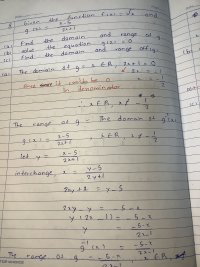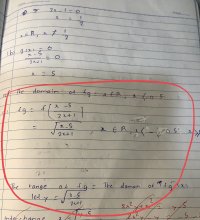You are using an out of date browser. It may not display this or other websites correctly.
You should upgrade or use an alternative browser.
You should upgrade or use an alternative browser.
I need a solution or explanation for (c). I get stuck in this problem.
- Thread starter Eric Thet
- Start date
D
Deleted member 4993
Guest
According to your textbook/class-notes:
What is the definition of "fg"?
Please share your work for parts 'a' & 'b'.
The definition of the fg (x) means a composite function and g acts on ( x ) first, then f conducts on the results.According to your textbook/class-notes:
What is the definition of "fg"?
Please share your work for parts 'a' & 'b'
 This is my solution for parts a and b. The results are checked out with the textbook‘s answers.
This is my solution for parts a and b. The results are checked out with the textbook‘s answers. When I reached to part c to solve,I am not able to figure out this and didn't get the correct answer.
When I reached to part c to solve,I am not able to figure out this and didn't get the correct answer.Dr.Peterson
Elite Member
- Joined
- Nov 12, 2017
- Messages
- 16,087
Thanks for showing what you've done, though it might have been helpful not to erase the work for (c), in case you were closer than you thought.The definition of the fg (x) means a composite function and g acts on ( x ) first, then f conducts on the results. View attachment 31033This is my solution for parts a and b. The results are checked out with the textbook‘s answers.View attachment 31034 When I reached to part c to solve,I am not able to figure out this and didn't get the correct answer.
The domain will be the set on which the radicand is non-negative (and exists). So solve the inequality [math]\frac{x-5}{2x+1}\ge 0[/math]
Do you know any methods for doing that?
pka
Elite Member
- Joined
- Jan 29, 2005
- Messages
- 11,971
To Eric Thet, As written it is domain & range of [imath]\Large fg[/imath] not [imath]\Large f\large \circ g[/imath]
I.e, product as opposed to composition.
Which one is it?
[imath][/imath][imath][/imath]
D
Deleted member 4993
Guest
According to his work,To Eric Thet, As written it is domain & range of [imath]\Large fg[/imath] not [imath]\Large f\large \circ g[/imath]
I.e, product as opposed to composition.
Which one is it?
[imath][/imath][imath][/imath]
fg = [imath]\Large f\large \circ g[/imath] ....................... hence it is the composition.
pka
Elite Member
- Joined
- Jan 29, 2005
- Messages
- 11,971
But what if it is a product and he read incorrectly??According to his work,
fg = [imath]\Large f\large \circ g[/imath] ....................... hence it is the composition.
Even though we don't gain the answer to this by solving it.Thanks for showing what you've done, though it might have been helpful not to erase the work for (c), in case you were closer than you thought.
The domain will be the set on which the radicand is non-negative (and exists). So solve the inequality [math]\frac{x-5}{2x+1}\ge 0[/math]
Do you know any methods for doing that?
Last edited:
Dr.Peterson
Elite Member
- Joined
- Nov 12, 2017
- Messages
- 16,087
I don't know what you mean by this. The solution to this inequality is the domain of the composite function.Even though we don't gain the answer to this by solving it.
Have you solved it?
He said it w
I would say [imath]2x + 1 > 0.[/imath]
But therefore
[math]2x + 1 > 0 \implies \dfrac{1}{2x + 1} > 0 \text { and}\\ 2x + 1 > 0 \implies x > - \dfrac{1}{2} \implies x + 5 > \dfrac{9}{2} > 0 \ge 0.\\ \therefore \dfrac{x + 5}{2x + 1} \ge 0.[/math]
Note that I am NOT saying his answer is wrong. I’d just prefer to state the constraint differently, namely as [imath]2x + 1 > 0 \implies x > - \dfrac{1}{2}.[/imath]
I must admit I find Dr. Peterson’s answer here to be a bit obscure.Even though we don't gain the answer to this by solving it.
I would say [imath]2x + 1 > 0.[/imath]
But therefore
[math]2x + 1 > 0 \implies \dfrac{1}{2x + 1} > 0 \text { and}\\ 2x + 1 > 0 \implies x > - \dfrac{1}{2} \implies x + 5 > \dfrac{9}{2} > 0 \ge 0.\\ \therefore \dfrac{x + 5}{2x + 1} \ge 0.[/math]
Note that I am NOT saying his answer is wrong. I’d just prefer to state the constraint differently, namely as [imath]2x + 1 > 0 \implies x > - \dfrac{1}{2}.[/imath]
Dr.Peterson
Elite Member
- Joined
- Nov 12, 2017
- Messages
- 16,087
Are we answering different questions?He said it w
I must admit I find Dr. Peterson’s answer here to be a bit obscure.
I would say [imath]2x + 1 > 0.[/imath]
But therefore
[math]2x + 1 > 0 \implies \dfrac{1}{2x + 1} > 0 \text { and}\\ 2x + 1 > 0 \implies x > - \dfrac{1}{2} \implies x + 5 > \dfrac{9}{2} > 0 \ge 0.\\ \therefore \dfrac{x + 5}{2x + 1} \ge 0.[/math]
Note that I am NOT saying his answer is wrong. I’d just prefer to state the constraint differently, namely as [imath]2x + 1 > 0 \implies x > - \dfrac{1}{2}.[/imath]
The question, as I understand it, is to find the domain of [imath]f\circ g(x) = \sqrt{\frac{x-5}{2x+1}}[/imath].
You are claiming, I think, that the domain is [imath]x>-\frac{1}{2}[/imath].
But, for example, if [imath]x=0[/imath], then [imath]f\circ g(0) = \sqrt{\frac{0-5}{2(0)+1}}=\sqrt{-5}[/imath], which is undefined.
And, on the other hand, if [imath]x=-1[/imath], then [imath]f\circ g(-1) = \sqrt{\frac{-1-5}{2(-1)+1}}=\sqrt{6}[/imath], which is defined.
You are right as usual. I had x + 5 in the numerator.Are we answering different questions?
The question, as I understand it, is to find the domain of [imath]f\circ g(x) = \sqrt{\frac{x-5}{2x+1}}[/imath].
You are claiming, I think, that the domain is [imath]x>-\frac{1}{2}[/imath].
But, for example, if [imath]x=0[/imath], then [imath]f\circ g(0) = \sqrt{\frac{0-5}{2(0)+1}}=\sqrt{-5}[/imath], which is undefined.
And, on the other hand, if [imath]x=-1[/imath], then [imath]f\circ g(-1) = \sqrt{\frac{-1-5}{2(-1)+1}}=\sqrt{6}[/imath], which is defined.
Dr.Peterson
Elite Member
- Joined
- Nov 12, 2017
- Messages
- 16,087
In that case, the domain would be [imath](-\infty,-5]\cup(-\frac{1}{2},\infty)[/imath].You are right as usual. I had x + 5 in the numerator.

